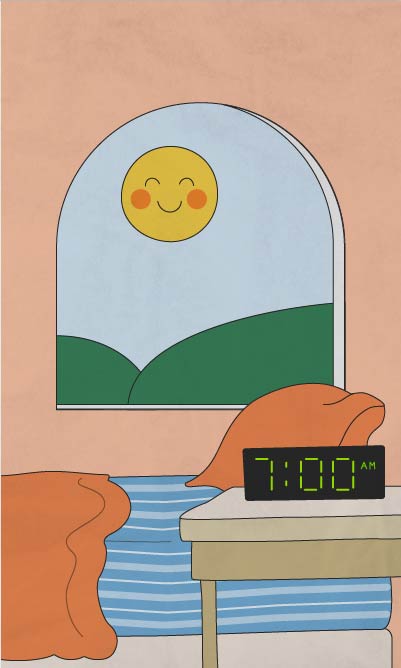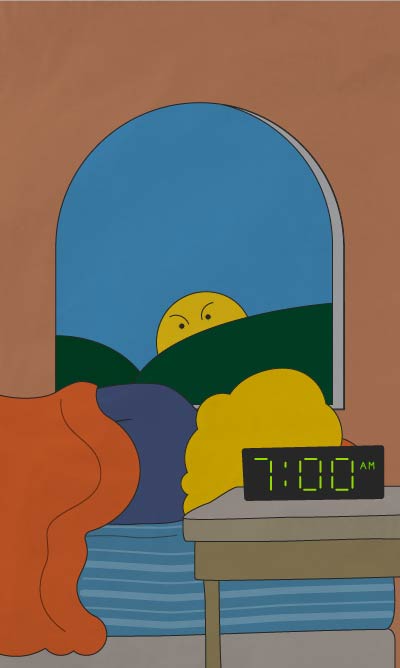
Should we keep the clocks sprung forward once and for all?
A writer who loves the Senate's move to make daylight saving time permanent and a writer who loathes it make their cases.
April 1, 2022
Click on one to read
More evening light? The Senate got it right this time.
By Judi Ketteler
When the Senate passed the Sunshine Protection Act a few weeks ago — which would keep us permanently on daylight saving time, starting in November 2023 — my first thought admittedly was, “Aren’t there more important things to be legislating right now?”
But then I thought about the dread I feel every March when the clocks spring forward and how this law would end the practice of switching clocks twice a year and keep us permanently on the schedule that we now only experience in March through early November.
Collectively losing an hour of sleep every spring is a troublesome business. When one person walks around feeling jet-lagged, it’s manageable. But when an entire population does? We’ve got a problem.
In fact, a 2020 study found that springing forward each year increases the risk of having a fatal traffic accident by 6 percent. It turns out that changing the external clocks affects our internal clocks. Scientists are still trying to understand the nuances of why driving is riskier right after the time change, but sleep deprivation is thought to be at least one factor. (The increased morning darkness after the spring switch may be another.)
You know what else goes up in March directly after the hour of lost sleep? Heart attacks. The University of Michigan found that there is a 24 percent increase in the number of heart attacks on the Monday following the switch to daylight saving time compared with any other Monday.
As for the shift back to standard time in the fall? A Danish study in the journal Epidemiology found an 11 percent increase in depressive episodes after the shift from daylight saving time back to standard time. The researchers said the feeling of gloom that can descend when daylight decreases may be one explanation.
In fact, I need zero research to tell me that I am crankier and my children are out of sorts following the spring forward. This year, on the Sunday of the time change, I wrote in my running journal: “Exhausted because of %!@$ time change!” And my middle school kids were extra challenging to rouse for school that Monday.
Switching the clocks made sense as a way to conserve fuel during World War I and World War II, the idea being that by pushing daylight to later in the day, people would spend more time outside in the evening and less time inside, where they had to turn on lights or use other resources. But why are we still doing this to ourselves now? If we keep the clocks constant at the “spring forward” setting, we won’t mess with our circadian rhythms twice each year, and we’ll still have more hours of daylight in the evening.
We know from studying seasonal affective disorder — a sometimes seasonal pattern of depression that tends to be linked to shorter days — that light affects our mood. The Danish study specifically listed SAD as a factor in the rise of depressive episodes.
While researchers don’t know exactly why some people feel more down when the days are shorter, they think it’s linked to the way light affects brain chemistry. Sunlight may have a role to play in maintaining serotonin levels. People with SAD are more sensitive to this and have lower serotonin levels when there is less daylight, the thinking goes.
I see this in my husband, who has struggled with anxiety and depression ever since I’ve known him. He uses various interventions to help manage it, and he’s mostly successful. But when November comes and daylight becomes scarce, his depression symptoms become more pronounced. We’ve tried just turning on more lights in the house, hoping to mimic light therapy, but it’s not the same.
To say my husband is cheerful after we switch the clocks forward would be an overstatement, considering he’s always a bit of an Eeyore, charmingly grumbling his way through life. But his mood is definitely lighter when the light is rearranged to coincide with free time after dinner, versus the morning rush of getting kids where they need to be. Could people like him, who are extra sensitive to light and dark, get a bit of a year-round mood lift if we permanently stay on daylight saving time?
As for me, it’s not a matter of serotonin. It’s about motivation. Darkness after our evening meal sends the message, “Ugh, you’re done for the day.” But light after dinner says, “Go make something of this evening!” With sunshine, being outside feels accessible even if it’s still chilly.
When I think back to the original lockdown that began in March 2020, the only bright spot was that people took advantage of walking outside. Here in my suburb of Cincinnati, as I worked in my garden or played volleyball in the yard with my 11-year-old daughter, more people walked my street than ever before. It wasn’t unusual to see as many as 100 people on the sidewalks over the course of an evening (pre-pandemic, I might have seen 10).
With little else to do, people went outside. Kids rode bikes. Neighbors talked across driveways. We even installed a Little Free Library after understanding that the chance of getting Covid-19 from a book was slim. When everything else about the world felt wrong, being outside in the evening light felt right.
While I don’t think it will save actual energy to stay on daylight saving time (it didn’t before when the country tried it in the 1970s), I think it will create people energy. I could use some of that.
Judi Ketteler writes about midlife in the Midwest and is the author of “Would I Lie to You? The Amazing Power of Being Honest in a World That Lies.”
You can’t legislate your way to more sunlight. Just wait for spring to come.
By Bradley Babendir
There is something beautiful about the history-repeating nature of permanent daylight saving time.
According to The Washington Post, in November and December 1973, up to 74 percent of the population wanted permanent daylight saving time. Congress said sure, OK, let’s try it. The policy was implemented in January the following year, and Americans could hardly stand it longer than Tom Brady could stay retired. Before the end of the month, The New York Times ran a story with the headline “Schools Ask End to Daylight Time.” By March, only 19 percent of people thought it was a good idea.
A recent YouGov poll showed that 59 percent of people want permanent daylight saving time. After suffering through months of dreary winter nights, why wouldn’t they? One of the perks of democracy is that you’re entitled to make the same mistakes over and over again if the mistakes are popular.
We are trapped in this futile cycle because all of our options are bad. The problem is not that it’s dark at this time or that. The problem is that it’s dark. The problem is that there’s not enough light; that the sun, in all its glory, distributes its brightness in meager, unsatisfying parcels for much of the calendar year.
The Senate recently approved a bill to make daylight saving time permanent, but you can’t legislate your way to more light. The United States has no coercive power over the sun. (That’s probably a good thing.) In the Western Hemisphere, from November to March, it’s just going to be too dark for too long every day.
Which is to say: Standard time stinks too. I hate taking my dog for a walk after work and being greeted by darkness. (I have a dog, not to brag.) She’s very little and very determined to eat whatever is in front of her. Her mouth is already so low to the ground. The absence of light gives her nose a significant advantage over my eyes. All early evening unpleasantries — errands, the commute, etc. — are made worse by the early darkness. It’s not a good way to end the day.
But it would not be a good way to start the day either. I hate taking my dog for a walk before work and being greeted by darkness. (Not sure if I mentioned: I have a dog.) I don’t like to start my day prying something from her mouth any more than I like to end my day that way. Performing the necessary tasks to get ready for the day — making coffee, feeding the cats (I’ve got cats too), etc. — is only made worse under artificial lighting.
Approaching the problem like it’s one that can be solved by shifting the hands on a clock this way or that is a recipe for a frustrating outcome. Neither is going to make you happy.
It is true that not changing the clock twice a year can save some hassle, but I, for one, would miss the spicy surprise of groggily trying to figure out what time it actually was before remembering that it was the day time jumped forward or skipped back.
Still, I know saying both answers are bad is unsatisfying. It feels good to make a decision, to be faced with a problem or inconvenience and to do something about it. But whenever this goes into effect, that something to do will be going back to the way things were. Luckily for us, standard time is a concept and not an entity with a personality, but it would feel like crawling back to an old ex nonetheless.
There is nothing we can do to get more light more often from the despicable sun. There is nothing we can do to fix the tilt of the Earth’s axis. We cannot solve those, which means we cannot solve the problem. Making one bad part of our lives somewhat better and another part of our lives somewhat worse will be unsatisfying at best. Even if we can avoid the 1970s panic about schoolchildren, as The New York Times put it, being “easy prey for drowsy motorists,” an insufferable National Conversation is inevitable. And it will be a nightmare.
In that same 1974 Times article, then-president of the Maine Senate, Kenneth P. MacLeod, was, like we are now, trapped with rules he didn’t like.
“In another couple of weeks, daylight saving time won't make much difference one way or the other,” he said. “Every day it gets a little lighter a little earlier.”
Whether it’s standard time or daylight saving time, there is only one thing to do in the dead of winter: wait for spring.
Bradley Babendir is a writer based in Somerville, MA.
This is a recurring series from @NBCNewsThink.
Illustrator:
JoElla Carman
Design and development:
Jiachuan Wu
Art director:
Chelsea Stahl


